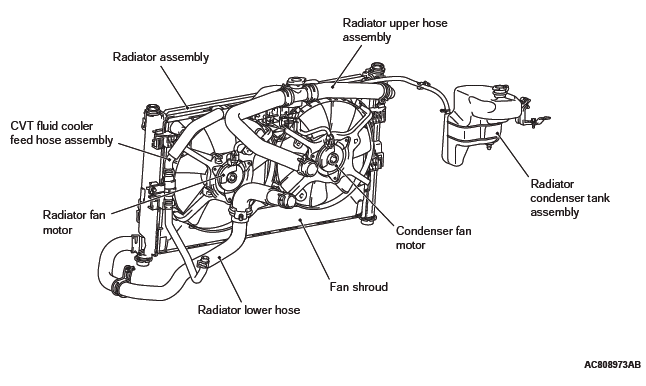Mitsubishi Outlander: Engine Cooling
General Information
The cooling system is designed to keep every part of
the engine at appropriate temperature in whatever
condition the engine may be operated. The cooling
method is of the water-cooled, pressure forced circulation
type in which the water pump pressurizes coolant
and circulates it throughout the engine. If the
coolant temperature exceeds the prescribed temperature,
the thermostat opens to circulate the coolant
through the radiator as well so that the heat
absorbed by the coolant may be radiated into the air.
The water pump is of the centrifugal impeller type
and is driven by the drive belt from the crankshaft
<2.4L ENGINE>. The water pump is of the centrifugal
impeller type and is driven by the timing belt from
the crankshaft <3.0L ENGINE>. The radiator is the
corrugated fin, cross flow type.
CONSTRUCTION DIAGRAM
<2.4L ENGINE>

<3.0L ENGINE>

Service Specifications

Coolant

NOTE: *similar high quality ethylene glycol based non-silicate, non-amine,
non-nitrate and non-borate coolant
with long life hybrid organic acid technology.
Sealant

READ NEXT:
INTRODUCTION
The system cools the engine so that it does not overheat
and maintains the engine at an optimum temperature.
The system components are the radiator,
water pump, thermostat, condenser fa
ENGINE COOLANT LEAK CHECK
WARNING
When pressure testing the cooling system, slowly
release cooling system pressure to avoid getting
burned by hot coolant.
CAUTION
Be sure to completely clean away a
REMOVAL AND INSTALLATION <2.4L ENGINE>
Pre-removal Operation
Engine Coolant Draining
Engine Upper Cover Removal
Air Cleaner Assembly Removal
Post-installation Operation
Air Cleaner Asse
SEE MORE:
If the engine cannot be started because the battery is weak or dead, the battery
from another vehicle can be used with jumper cables to start the engine.
WARNING:
● To start the engine using jumper cables connected to another vehicle, perform
the correct procedures according to the instr
REMOVAL AND INSTALLATION <2.4L ENGINE>
Pre-removal operation
Engine coolant Draining
Air Cleaner Assembly Removal
Post-installation operation
Air Cleaner Assembly Installation
Engine Coolant Refilling and Check
Radiator removal steps
Engine room under cover front
Radiator drain
© 2010-2025 Copyright www.mioutlander.com







